1.1 Module 83: History and Alternative Views of Macroeconomics
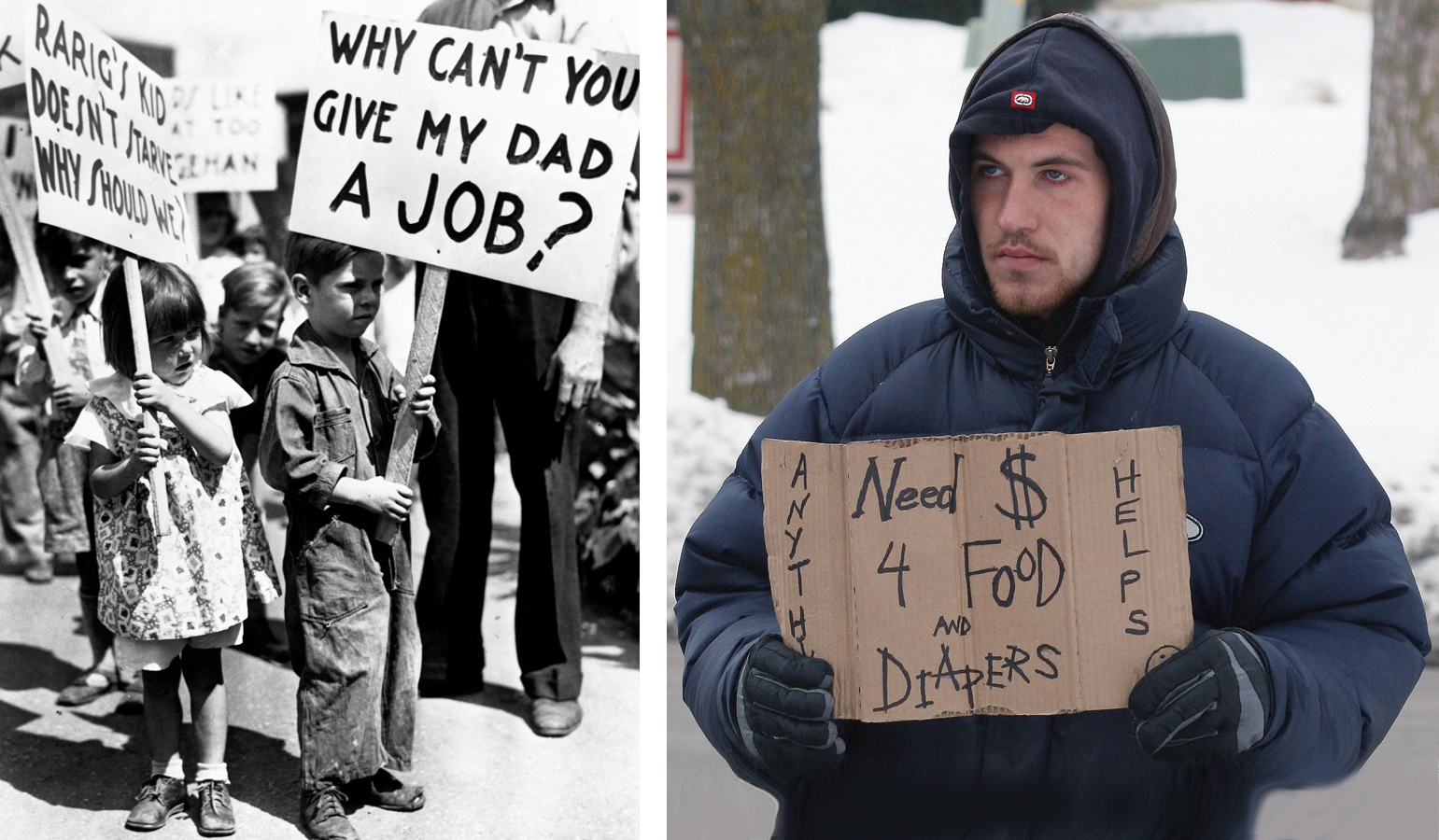
Thomas W. Elliott
WHAT YOU WILL LEARN
 Why classical macroeconomics wasn’t adequate for the problemss posed by the Great Depression
Why classical macroeconomics wasn’t adequate for the problemss posed by the Great Depression
 How Keynes and the experience of the Great Depression legitimized macroeconomic policy activism
How Keynes and the experience of the Great Depression legitimized macroeconomic policy activism
 What monetarism is and its views about the limits of discretionary monetary policy
What monetarism is and its views about the limits of discretionary monetary policy
 How challenges led to a revision of Keynesian ideas and the emergence of the new classical macroeconomics
How challenges led to a revision of Keynesian ideas and the emergence of the new classical macroeconomics
Classical Macroeconomics
The term macroeconomics appears to have been coined in 1933 by the Norwegian economist Ragnar Frisch. The timing, during the worst year of the Great Depression, was no accident. Still, there were economists analyzing what we now consider macroeconomic issues—
Money and the Price Level
Previously, we described the classical model of the price level. According to the classical model, prices are flexible, making the aggregate supply curve vertical even in the short run. In this model, an increase in the money supply leads, other things equal, to a proportional rise in the aggregate price level, with no effect on aggregate output. As a result, increases in the money supply lead to inflation, and that’s all. Before the 1930s, the classical model of the price level dominated economic thinking about the effects of monetary policy.
Did classical economists really believe that changes in the money supply affected only aggregate prices, without any effect on aggregate output? Probably not. Historians of economic thought argue that before 1930 most economists were aware that changes in the money supply affected aggregate output as well as aggregate prices in the short run—
The Business Cycle
Classical economists were, of course, also aware that the economy did not grow smoothly. The American economist Wesley Mitchell pioneered the quantitative study of business cycles. In 1920, he founded the National Bureau of Economic Research, an independent, nonprofit organization that to this day has the official role of declaring the beginnings of recessions and expansions. Thanks to Mitchell’s work, the measurement of business cycles was well advanced by 1930. But there was no widely accepted theory of business cycles.
In the absence of any clear theory, views about how policy makers should respond to a recession were conflicting. Some economists favored expansionary monetary and fiscal policies to fight a recession. Others believed that such policies would worsen the slump or merely postpone the inevitable. When the Great Depression hit, the policy making process was paralyzed by this lack of consensus. In many cases, economists now believe, policy makers took steps in the wrong direction.
Necessity was, however, the mother of invention. As we’ll explain next, the Great Depression provided a strong incentive for economists to develop theories that could serve as a guide to policy—
The Great Depression and the Keynesian Revolution
The Great Depression demonstrated, once and for all, that economists cannot safely ignore the short run. Not only was the economic pain severe, it threatened to destabilize societies and political systems.
The whole world wanted to know how this economic disaster could be happening and what should be done about it. But because there was no widely accepted theory of the business cycle, economists gave conflicting and, we now believe, often harmful advice. Some believed that only a huge change in the economic system—
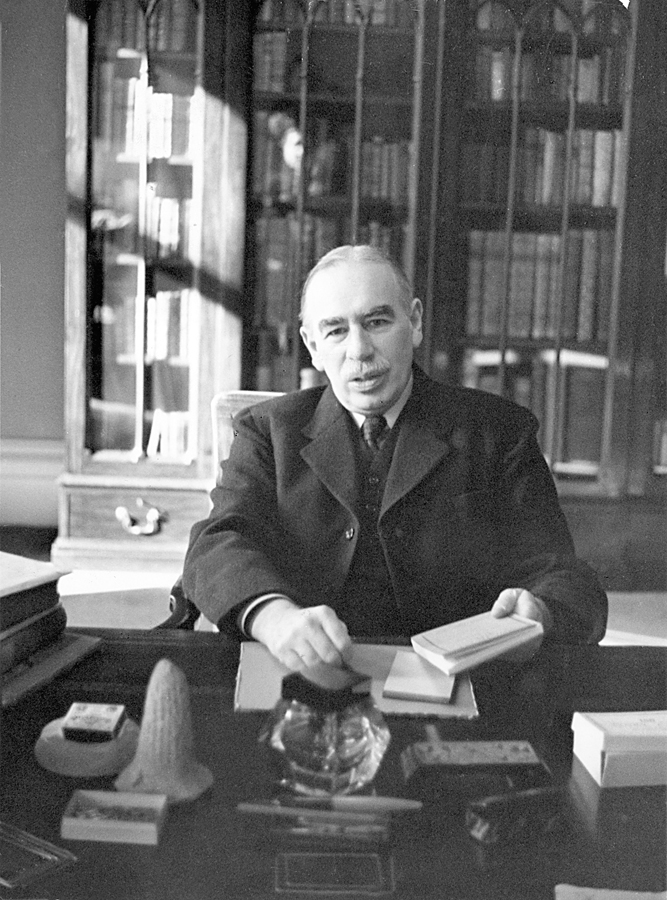
Some economists, however, argued that the slump both could have and should have been cured—
Nice metaphor. But what was the nature of the trouble?
Keynes’s Theory
In 1936, Keynes presented his analysis of the Great Depression—
Keynes’s book is a vast stew of ideas. And Keynesian economics mainly reflected two innovations. First, Keynes emphasized the short-
Figure 83-1 illustrates the difference between Keynesian and classical macroeconomics. Both panels of the figure show the short-

Panel (a) shows the classical view: the short-
As we’ve already explained, many classical macroeconomists would have agreed that panel (b) was an accurate story in the short run—
Second, classical economists emphasized the role of changes in the money supply in shifting the aggregate demand curve, paying little attention to other factors. Keynes, however, argued that other factors, especially changes in “animal spirits”—these days usually referred to with the bland term business confidence—are mainly responsible for business cycles. Before Keynes, economists often argued that a decline in business confidence would have no effect on either the aggregate price level or aggregate output, as long as the money supply stayed constant. Keynes offered a very different picture.
Keynes’s ideas have penetrated deeply into the public consciousness, to the extent that many people who have never heard of Keynes, or have heard of him but think they disagree with his theory, use Keynesian ideas all the time. For example, suppose that a business commentator says something like this: “Because of a decline in business confidence, investment spending slumped, causing a recession.” Whether the commentator knows it or not, that statement is pure Keynesian economics.
Policy to Fight Recessions
Macroeconomic policy activism is the use of monetary and fiscal policy to smooth out the business cycle.
The main practical consequence of Keynes’s work was that it legitimized macroeconomic policy activism—the use of monetary and fiscal policy to smooth out the business cycle.
Macroeconomic policy activism wasn’t something completely new. Before Keynes, many economists had argued for using monetary expansion to fight economic downturns—
After World War II, Keynesian ideas were broadly accepted by U.S. economists. There were, however, a series of challenges to those ideas, which led to a considerable shift in views even among economists who continued to believe that Keynes was broadly right about the causes of recessions. In the upcoming section, we’ll learn about those challenges and the schools, new classical economics and new Keynesian economics, that emerged.
THE END OF THE GREAT DEPRESSION
It would make a good story if Keynes’s ideas had led to a change in economic policy that brought the Great Depression to an end. Unfortunately, that’s not what happened. Still, the way the Depression ended did a lot to convince economists that Keynes was right.
The basic message many of the young economists who adopted Keynes’s ideas in the 1930s took from his work was that economic recovery requires aggressive fiscal expansion—
Figure 83-2 shows the U.S. unemployment rate and the federal budget deficit as a share of GDP from 1930 to 1947. As you can see, deficit spending during the 1930s was on a modest scale. In 1940, as the risk of war grew larger, the United States began a large military buildup, and the budget moved deep into deficit. After the attack on Pearl Harbor on December 7, 1941, the country began deficit spending on an enormous scale: in fiscal 1943, which began in July 1942, the deficit was 30% of GDP. Today that would be a deficit of $5.0 trillion.
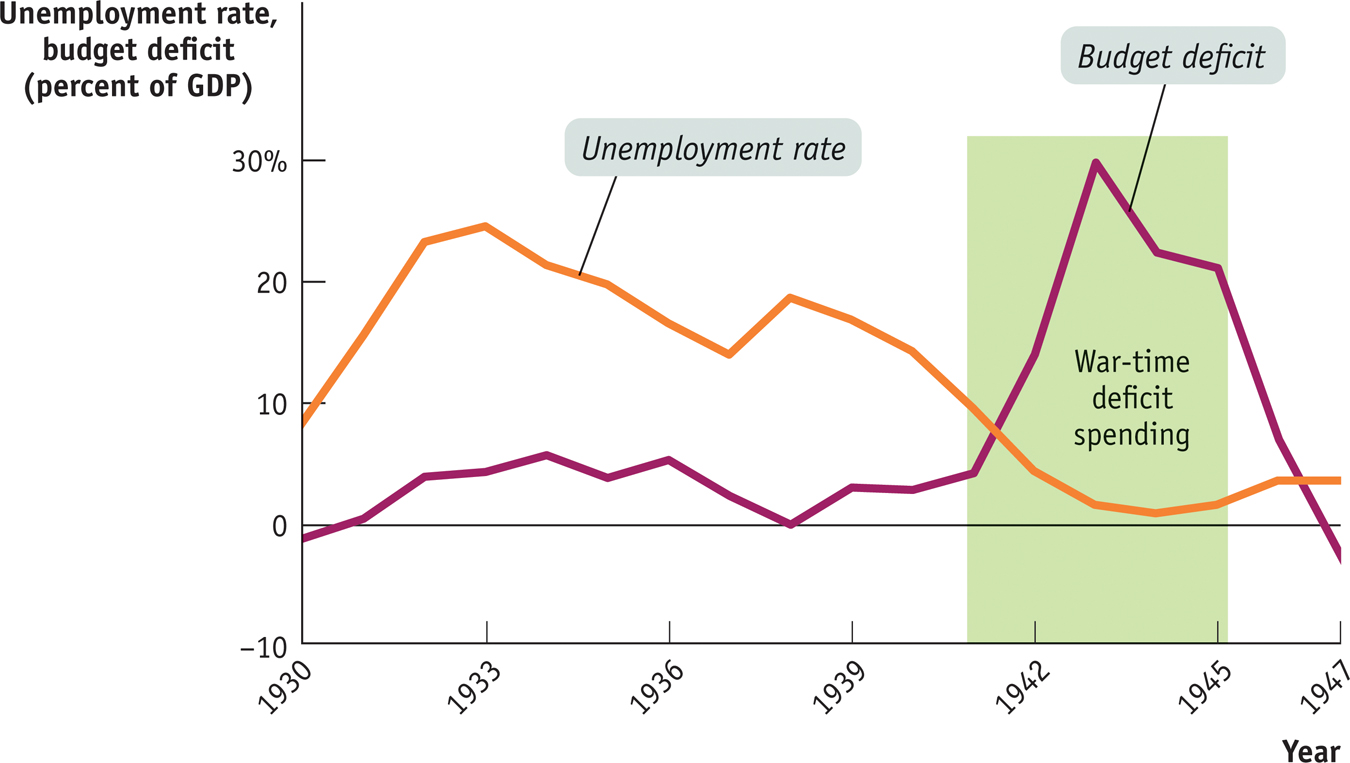
And the economy recovered. World War II wasn’t intended as a Keynesian fiscal policy, but it demonstrated that expansionary fiscal policy can, in fact, create jobs in the short run.
Challenges to Keynesian Economics
Keynes’s ideas fundamentally changed the way economists think about business cycles. They did not, however, go unquestioned. In the decades that followed the publication of The General Theory, Keynesian economics faced a series of challenges. As a result, the consensus of macroeconomists retreated somewhat from the strong version of Keynesianism that prevailed in the 1950s. In particular, economists became much more aware of the limits to macroeconomic policy activism.
The Revival of Monetary Policy
Keynes’s General Theory suggested that monetary policy wouldn’t be very effective in depression conditions. Many modern macroeconomists agree: earlier we introduced the concept of a liquidity trap, a situation in which monetary policy is ineffective because the interest rate is down against the zero bound. In the 1930s, when Keynes wrote, interest rates were, in fact, very close to 0%.
But even when the era of near-

Teresa Zabala/The New York Times/Redux
Friedman and Schwartz showed that business cycles had historically been associated with fluctuations in the money supply. In particular, the money supply fell sharply during the onset of the Great Depression. Friedman and Schwartz persuaded many, though not all, economists that the Great Depression could have been avoided if the Federal Reserve had acted to prevent that monetary contraction and that monetary policy should play a key role in economic management.
The revival of interest in monetary policy was significant because it suggested that the burden of managing the economy could be shifted away from fiscal policy—
Monetary policy, in contrast, does not involve such choices: when the central bank cuts interest rates to fight a recession, it cuts everyone’s interest rate at the same time. So a shift from relying on fiscal policy to relying on monetary policy makes macroeconomics a more technical, less political issue. In fact, monetary policy in most major economies is set by an independent central bank that is insulated from the political process.
Monetarism
Monetarism asserts that GDP will grow steadily if the money supply grows steadily.
After the publication of A Monetary History, Milton Friedman led a movement, called monetarism, that sought to eliminate macroeconomic policy activism while maintaining the importance of monetary policy. Monetarism asserted that GDP will grow steadily if the money supply grows steadily. The monetarist policy prescription was to have the central bank target a constant rate of growth of the money supply, such as 3% per year, and maintain that target regardless of any fluctuations in the economy.
It’s important to realize that monetarism retained many Keynesian ideas. Like Keynes, Friedman asserted that the short run is important and that short-
Discretionary monetary policy is the use of changes in the interest rate or the money supply to stabilize the economy.
Monetarists argued, however, that most of the efforts of policy makers to smooth out the business cycle actually make things worse. We have already discussed concerns over the usefulness of discretionary fiscal policy—changes in taxes or government spending, or both—
Friedman also argued that if the central bank followed his advice and refused to change the money supply in response to fluctuations in the economy, fiscal policy would be much less effective than Keynesians believed. Earlier we analyzed the phenomenon of crowding out, in which government deficits drive up interest rates and lead to reduced investment spending. Friedman and others pointed out that if the money supply is held fixed while the government pursues an expansionary fiscal policy, crowding out will limit the effect of the fiscal expansion on aggregate demand.
Figure 83-3 illustrates this argument. Panel (a) shows aggregate output and the aggregate price level. AD1 is the initial aggregate demand curve and SRAS is the short-
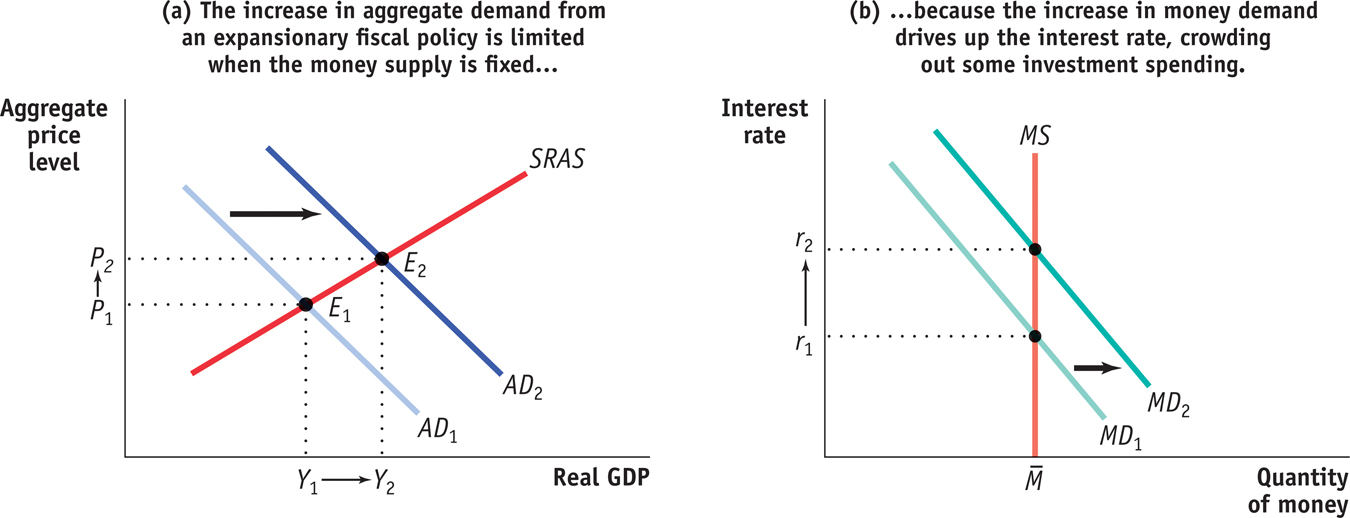
Now suppose the government increases purchases of goods and services. We know that this will shift the AD curve rightward, as illustrated by the shift from AD1 to AD2; that aggregate output will rise, from Y1 to Y2; and that the aggregate price level will rise, from P1 to P2. Both the rise in aggregate output and the rise in the aggregate price level will, however, increase the demand for money, shifting the money demand curve rightward from MD1 to MD2. This drives up the equilibrium interest rate to r2. Friedman’s point was that this rise in the interest rate reduces investment spending, partially offsetting the initial rise in government spending. As a result, the rightward shift of the AD curve is smaller than multiplier analysis indicates. And Friedman argued that with a constant money supply, the multiplier is so small that there’s not much point in using fiscal policy, even in a depressed economy.
A monetary policy rule is a formula that determines the central bank’s actions.
But Friedman didn’t favor activist monetary policy either. He argued that the problem of time lags that limit the ability of discretionary fiscal policy to stabilize the economy also apply to discretionary monetary policy. Friedman’s solution was to put monetary policy on “autopilot.” The central bank, he argued, should follow a monetary policy rule, a formula that determines its actions and leaves it relatively little discretion. During the 1960s and 1970s, most monetarists favored a monetary policy rule of slow, steady growth in the money supply.
Underlying this view was the Quantity Theory of Money, which relies on the concept of the velocity of money, the ratio of nominal GDP to the money supply. Velocity is a measure of the number of times the average dollar bill in the economy turns over per year between buyers and sellers (e.g., I tip the Starbucks barista a dollar, she uses it to buy lunch, and so on). This concept gives rise to the velocity equation:
The Quantity Theory of Money emphasizes the positive relationship between the price level and the money supply. It relies on the velocity equation (M × V = P × Y).
The velocity of money is the ratio of nominal GDP to the money supply. It is a measure of the number of times the average dollar bill is spent per year.
(83-
Where M is the money supply, V is velocity, P is the aggregate price level, and Y is real GDP.
Monetarists believed, with considerable historical justification, that the velocity of money was stable in the short run and changed only slowly in the long run. As a result, they claimed, steady growth in the money supply by the central bank would ensure steady growth in spending, and therefore in GDP.
Monetarism strongly influenced actual monetary policy in the late 1970s and early 1980s. It quickly became clear, however, that steady growth in the money supply didn’t ensure steady growth in the economy: the velocity of money wasn’t stable enough for such a simple policy rule to work.
Figure 83-4 shows how events eventually undermined the monetarists’ view. The figure shows the velocity of money, as measured by the ratio of nominal GDP to M1, from 1960 to 2013. As you can see, until 1980, velocity followed a fairly smooth, seemingly predictable trend. After the Fed began to adopt monetarist ideas in the late 1970s and early 1980s, however, the velocity of money began moving erratically—
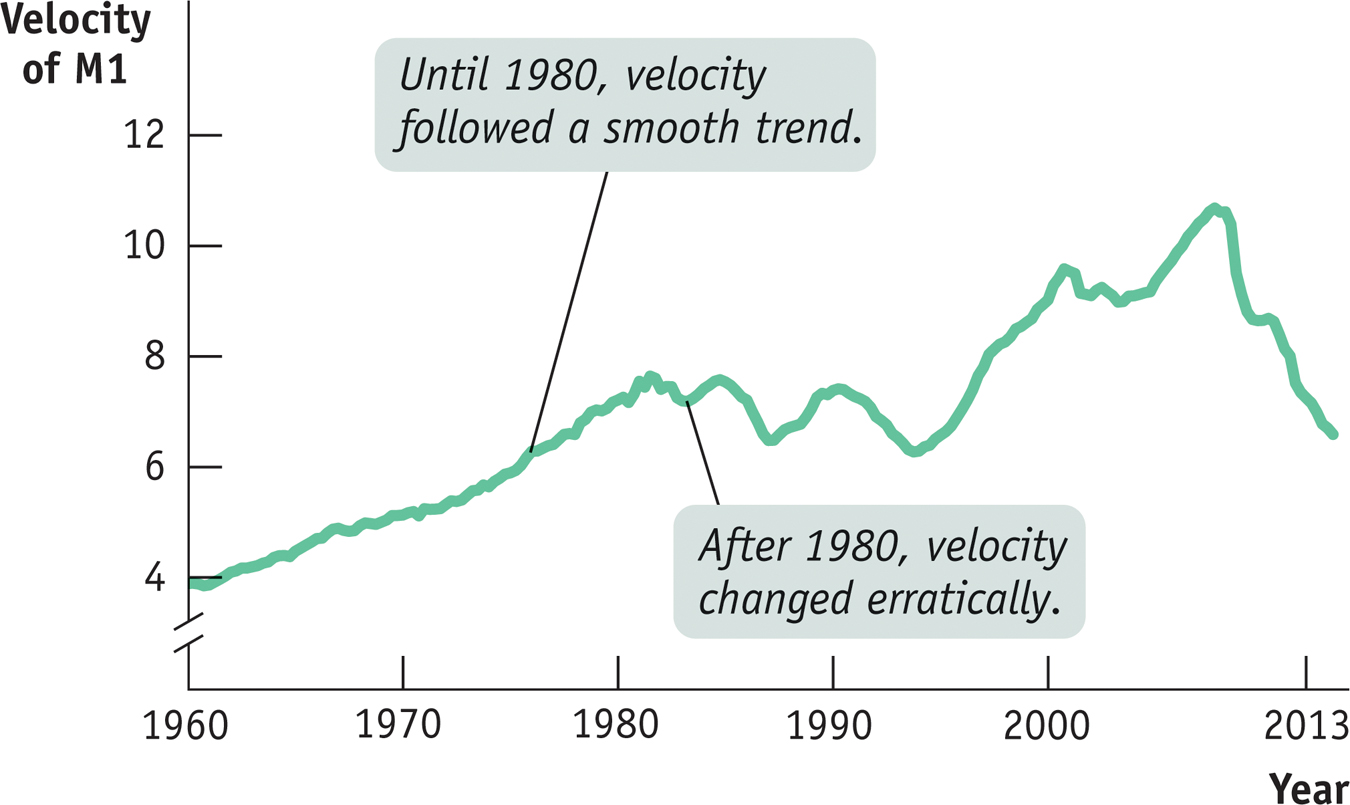
Traditional monetarists are hard to find among today’s macroeconomists. As we’ll see later, however, the concern that originally motivated the monetarists—
Inflation and the Natural Rate of Unemployment
At the same time that monetarists were challenging Keynesian views about how macroeconomic policy should be conducted, other economists—
In the 1940s and 1950s, many Keynesian economists believed that expansionary fiscal policy could be used to achieve full employment on a permanent basis. In the 1960s, however, many economists realized that expansionary policies could cause problems with inflation, but they still believed policy makers could choose to trade off low unemployment for higher inflation even in the long run.
According to the natural rate hypothesis, to avoid accelerating inflation over time, the unemployment rate must be high enough that the actual inflation rate equals the expected inflation rate.
In 1968, however, Edmund Phelps of Columbia University and Milton Friedman, working independently, proposed the concept of the natural rate of unemployment. Earlier you learned that the natural rate of unemployment is also the nonaccelerating inflation rate of unemployment, or NAIRU. According to the natural rate hypothesis, because inflation is eventually embedded in expectations, to avoid accelerating inflation over time, the unemployment rate must be high enough that the actual inflation rate equals the expected rate of inflation. Attempts to keep the unemployment rate below the natural rate will lead to an ever-
The natural rate hypothesis limits the role of activist macroeconomic policy compared to earlier theories. Because the government can’t keep unemployment below the natural rate, its task is not to keep unemployment low but to keep it stable—to prevent large fluctuations in unemployment in either direction.
The Friedman–
The Political Business Cycle
One final challenge to Keynesian economics focused not on the validity of the economic analysis but on its political consequences. A number of economists and political scientists pointed out that activist macroeconomic policy lends itself to political manipulation.
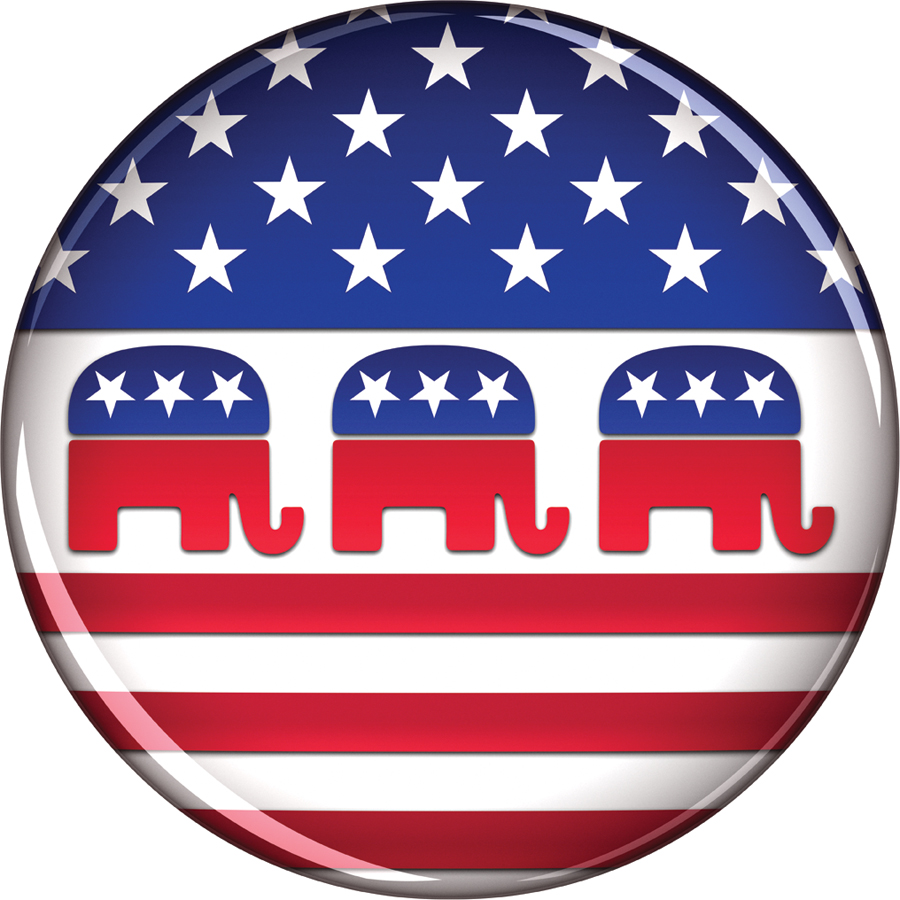
A political business cycle results when politicians use macroeconomic policy to serve political ends.
Statistical evidence suggests that election results tend to be determined by the state of the economy in the months just before the election. In the United States, if the economy is growing rapidly and the unemployment rate is falling in the six months or so before Election Day, the incumbent party tends to be re-

This creates an obvious temptation to abuse activist macroeconomic policy: pump up the economy in an election year, and pay the price in higher inflation and/or higher unemployment later. The result can be unnecessary instability in the economy, a political business cycle caused by the use of macroeconomic policy to serve political ends.
An often-
One way to avoid a political business cycle is to place monetary policy in the hands of an independent central bank, insulated from political pressure. The political business cycle is also a reason to limit the use of discretionary fiscal policy to extreme circumstances.
Rational Expectations, Real Business Cycles, and New Classical Macroeconomics
As we have seen, one key difference between classical economics and Keynesian economics is that classical economists believed that the short-
The challenges to Keynesian economics that arose in the 1950s and 1960s—
New classical macroeconomics is an approach to the business cycle that returns to the classical view that shifts in the aggregate demand curve affect only the aggregate price level, not aggregate output.
In the 1970s and 1980s, however, some economists developed an approach to the business cycle known as new classical macroeconomics, which returned to the classical view that shifts in the aggregate demand curve affect only the aggregate price level, not aggregate output. The new approach evolved in two steps. First, some economists challenged traditional arguments about the slope of the short-
Rational Expectations
Rational expectations is the view that individuals and firms make decisions optimally, using all available information.
In the 1970s, a concept known as rational expectations had a powerful impact on macroeconomics. Rational expectations, a theory originally introduced by John Muth in 1961, is the view that individuals and firms make decisions optimally, using all available information.
For example, workers and employers bargaining over long-
Rational expectations can significantly alter policy makers’ beliefs about the effectiveness of government policy. According to the original version of the natural rate hypothesis, a government attempt to trade off higher inflation for lower unemployment would work in the short run but would eventually fail because higher inflation would get built into expectations.
According to rational expectations, we should remove the word eventually: if it’s clear that the government intends to trade off higher inflation for lower unemployment, the public will understand this, and expected inflation will immediately rise. So, under rational expectations, government intervention fails in the short run and the long run.
In the 1970s, Robert Lucas of the University of Chicago used this logic to argue that monetary policy can change the level of unemployment only if it comes as a surprise to the public. If his analysis was right, monetary policy isn’t useful in stabilizing the economy after all. In 1995 Lucas won the Nobel Prize in economics for this work, which remains widely admired. However, many—
According to new Keynesian economics, market imperfections can lead to price stickiness for the economy as a whole.
Why, in the view of many macroeconomists, doesn’t the rational expectations hypothesis accurately describe how the economy behaves? New Keynesian economics, a set of ideas that became influential in the 1990s, provides an explanation. It argues that market imperfections interact to make many prices in the economy temporarily sticky. For example, one new Keynesian argument points out that monopolists don’t have to be too careful about setting prices exactly “right”: if they set a price a bit too high, they’ll lose some sales but make more profit on each sale; if they set the price too low, they’ll reduce the profit per sale but sell more. As a result, even small costs to changing prices can lead to substantial price stickiness and make the economy as a whole behave in a Keynesian fashion.
Over time, new Keynesian ideas combined with actual experience have reduced the practical influence of the rational expectations concept. Nonetheless, the idea of rational expectations served as a useful caution for macroeconomists who had become excessively optimistic about their ability to manage the economy.
Real Business Cycles
Real business cycle theory claims that fluctuations in the rate of growth of total factor productivity cause the business cycle.
Earlier we introduced the concept of total factor productivity, the amount of output that can be generated with a given level of factor inputs. Total factor productivity grows over time, but that growth isn’t smooth. In the 1980s, a number of economists argued that slowdowns in productivity growth, which they attributed to pauses in technological progress, are the main cause of recessions. Real business cycle theory claims that fluctuations in the rate of growth of total factor productivity cause the business cycle.
Believing that the aggregate supply curve is vertical, real business cycle theorists attribute the source of business cycles to shifts of the aggregate supply curve: a recession occurs when a slowdown in productivity growth shifts the aggregate supply curve leftward, and a recovery occurs when a pickup in productivity growth shifts the aggregate supply curve rightward. In the early days of real business cycle theory, the theory’s proponents denied that changes in aggregate demand—
This theory was strongly influential, but the current status of real business cycle theory is somewhat similar to that of rational expectations. The theory is widely recognized as having made valuable contributions to our understanding of the economy, and it serves as a useful caution against too much emphasis on aggregate demand.
But many of the real business cycle theorists themselves now acknowledge that their models need an upward-
Module 83 Review
Solutions appear at the back of the book.
Check Your Understanding
When Ben Bernanke, in his tribute to Milton Friedman, said that “Regarding the Great Depression…we did it,” he was referring to the fact that the Federal Reserve at the time did not pursue expansionary monetary policy. Why would a classical economist have thought that action by the Federal Reserve would not have made a difference in the length or depth of the Great Depression?
Consider Figure 83-4.
-
a. If the Federal Reserve had pursued a monetarist policy of a constant rate of growth in the money supply, what would have happened to output beginning in 2008 according to the velocity equation?
-
b. In fact, the Federal Reserve accelerated the rate of growth in M1 rapidly beginning in 2008, partly in order to counteract a large increase in unemployment. Would a monetarist have agreed with this policy? What limits are there, according to a monetarist point of view, to changing the unemployment rate?
-
What are the limits of macroeconomic policy activism?
In late 2008, as it became clear that the United States was experiencing a recession, the Fed reduced its target for the federal funds rate to near zero, as part of a larger aggressively expansionary monetary policy stance (including what the Fed called “quantitative easing”). Most observers agreed that the Fed’s aggressive monetary expansion helped reduce the length and severity of the 2007–
2009 recession. -
a. What would rational expectations theorists say about this conclusion?
-
b. What would real business cycle theorists say?
-
Multiple-
Question
AX+tnGQbObOuIF2xzYkcSf6Ujpp5awss+Qny3Rpym8ay8thVVCODyVJ8xdn/eASRo1m9Bh/RnVb3Wl0zAGrW3gIwpB004jrpy/Qig0xEslQQanCNx2RbJFJdYrcnCkYOvUPkF0oydSPcY8mzUu8IOuCxPGp6fdjVRaJskX6CaGSEXquYXfzl3pVEfa3CpiDXXwM4vf00NE+HEvXchJrXKtDHTuCqVsxdSzszrDAnBelRce1PsxqmxOHK7FIrN+fgPngbE9rTOGuEFjoeowBJWPyLexeAZXzRbB6w4SKTTY9RdZw3oZCkh9rUntmnNoyHuDd2m5Y66xtLAVdNAerlGptbnaSMRxXRbtdobdNWSLnJW2FskkDse37Hz2lGRRO7SnIYOcsvzzGjwn4/NYRIZBpDGsiZBF/oMkgEtg3oNh4hGt74mTFeOkHVr39sfaYpKyLU96w5C9N3E///6DFJ5l4De6jxqoT5SWl5LeRJECNTfX6+YXqbKxAWsoBGehIqqq0/SbHWlZqAeO75BdavgQhefQZrV0Vn1rq9+O9dCOPOmP2Jr293huc5pvaOpsIIQuestion
EfYxH8FPutA1qvJbYzN9QasEjPGW7k5RetussdDA4pfjJnG7uZhfXtJbDSgPxiekXLAQEApByjg65B5hrVxAe8FFtr66pJz4lLXuEjjCkIe5134WGyncRbfUipBuE+WzWCYY11ClBO5WpsHkqKUzNV+VDHqj8mt8X2T64Fv+dH9HiWl7r5k4y9hCAuM5J26eJoh1c8tYpKH1ff9OC5sq5tTjzdDl1pgfuoZzogXKtErzkeeLPqZCDSrDv2G6O10sRLXc5mctAiCQ2b6mUx626S2Zty2VCD1mvXKHS3ea0ybmZTsiafIbU7e7qrxw4w+SEsfXbvbncy41vaPk2+KIqUuvn1asbfiFkmKWj+cmQftuLxCMfe3woklf8Pgfif5uSbPP59nHtECdqKQhUCi7bRBSav03QP5Hp3m4+K7YD9ck3GRHP6R9VgkRzWMxvU/OrfKWRf5/tKnEVdFy4ZM0Ad7hgGJ/PB9225heasdZ6Thg4yipYEjE6KJ+NQITkMdK84Z0zQ==Question
uT/L2jJ1rwIv8/DJ4ZgJgL2ovikLR6sJjFR2vwcPpciYXsBbLcbuNewS8H0rp1YpJAGVjfn5kZqDyfiobjVxw6A5U6K8snAnKYA/YBTZexOi0JOlr3b008u+Y2qdWlkzDnP8Sb6WwginRsq6308GaltKcaErnT6LNtZ1OZocZWKCEdFYmDONI5oWyvQpXz5fX4xUAcb/iWoGdIjIRRqO3bKALof1o/FIUivCKGUW9aowPEiauS+xJRnbByW+eBqyYmD1cieVVxrsGERAOVpGB+rWZO3BNxbV/CodjhVQz1TtWqiISu+Iiuct1JZqfg1dMRwea69utcLn25qct00L6NHyLGU5yoYQ6UKm7kY3XafWZMsbQuestion
Y5tTLo0VT7pvuRamrYIm24dz4eyjqQt8u5PZMb9otHn1CLRxRoag/pH3Aqsh/37gTdx/uthiK2vKhi7mzGOldooSKG2xMnmqup3jyB8Jze6LGlvzKtZbgxVLfhl3LJYnQRcTOBnDYl7ZWMJaOmA4x+OE7eZ8nNSlgK4ksN8L+OQvdMvuZWS//OxWpIUCuq72mApiP1/PPGTvX0xLiXxkjpEIXWSOmU/88XUU1iYUo301mmBBjENLnBr5xlYJy9pJ+XykIrphGwx6+iLy2JcUQUtY9aN3/3S0fZCdizlcQGo0e9yBfx8AtZe72fi9G+FLlyClHjpkhqt+CTKkTPFsshdP8T35WxGigF+YFznDPB+2tyiu4RjLc4B+hd32nMnMtZzmB4vBIkVyykvDN8rRcsBsCjp0HqYhRmXA2e+ml6fg0xrFb01T1aHzbyq9ddflMkR5iyCqefhhq4ijpPKollHebtyyGW+1bj/I+RicFABWHGmeNyU501No0b3rIgr2YNwXa30SJH7/eSJTCmSMr3qkcCFP7crKDBnEsuFfUlbg7eMfkymOvy3A+kQ8amxpYe4HSQcOYGrV8CaqWit+TKtmOEFFDtV6qxxph+bJRkXGIqo9FCp2pjT0w/cP4Umb6oDVUvGCdZEONP5sINSpAWXzBFJ47gbwr0g/0X+D+U+e61FI62wz3pqsBnEgJCdzt5tY/HKmWLY6rEpc2I/Ohx0Jva4WZy9GHwRy59iMDv8m/uzkFtMgFHLgT3JnKN6bpihwute9QdMxnDLRJyiIIVcs0Nd1mnkgXum4cifYLGveipSugwqY8Yn9FmTIkToC6ykITzVMSfbpPBDCCaIJAPNQjbfg0l0TW6hEFNVmgtcSQI9aCk+pUTcGFnWs4Yv88po/gNHf1Yk3J6w5QhwGizfBihYHQBLqsKSobkwXNyN0axFgQuestion
XhQ6pHjJIVp4QA6BbcVcApYKYwNOCuJ+pnszKqzUs8uikc1Leqo3nkSgjMkW21u9x9JgzLJBzUGKCu1EsqXHkxyFCHRaAXWHtmx+POatHeIoULhkDnCja63mVjK7JxQKa1latVwJn+gIii5WUFB+BSqrQ54YK7oVCOuGz05S4Br6nF9Ml1bgCNadBnGqKV82gpTVJY+txy0aAH1gaE9p/ue2sqM67+mgxbz7cSKgWONPjLIzdlcsi4VUZsZx3iY0kgUveqyR2SBxcMjKkhewTQRVUDSdUGf9KD9nIruhHTdiFc5MPaPlvAmo8h0=
Critical-
For each of the following economic theories, identify its fundamental conclusion.
- a. the classical model of the price level
- b. Keynesian economics
- c. monetarism
- d. the natural rate hypothesis
- e. rational expectations
- f. real business cycle theory